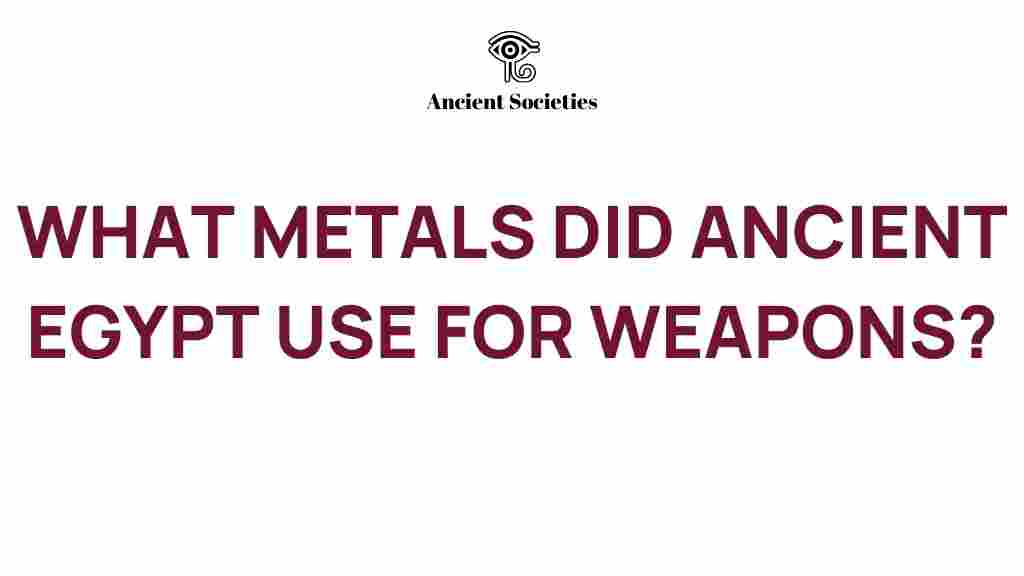Unveiling the Secrets: What Metals Fueled Ancient Egypt’s Warfare?
Ancient Egypt is renowned for its rich history, monumental architecture, and advanced technology. Among these remarkable achievements, the development of metallurgy played a crucial role in shaping the military capabilities of this ancient civilization. This article delves into the secrets of the metals that fueled Ancient Egypt’s warfare, focusing on the significance of copper and bronze in the evolution of weapons and armor, the role of metallurgy in military strategy, and the archaeological findings that shed light on these practices.
The Role of Metals in Ancient Egyptian Warfare
Metallurgy was a revolutionary technology that transformed the way Ancient Egyptians approached warfare. Before the advent of metalworking, weapons were primarily made from stone, wood, and bone. The discovery of metals introduced new materials that enhanced the effectiveness of their weaponry.
Key metals used in Ancient Egyptian warfare included:
- Copper: The first metal to be extensively used for tools and weapons.
- Bronze: An alloy of copper and tin that provided superior strength and durability.
The Advent of Copper in Ancient Egypt
Copper was one of the first metals used by humans, and its introduction into Ancient Egypt marked a significant technological advancement. Dating back to around 4000 BCE, copper was initially sourced from native deposits.
Weapons made from copper included:
- Swords: Early forms were short and designed for slashing rather than thrusting.
- Axes: Used both as weapons and tools, these were essential in combat and daily life.
- Spears: Copper spearheads were more effective than their stone counterparts.
As copper technology evolved, the Egyptians began to refine their techniques, leading to the production of stronger and sharper weapons.
The Transition to Bronze: A Game Changer in Warfare
By around 3000 BCE, the introduction of bronze—a much harder metal alloy—significantly altered the landscape of warfare in Ancient Egypt. Bronze is created by combining copper with tin, and its properties made it ideal for crafting more effective weapons.
Advantages of bronze included:
- Durability: Bronze weapons could withstand more wear and tear compared to copper.
- Sharper Edges: The alloy could be tempered to create sharper blades.
- Resistance to Corrosion: Bronze was less susceptible to rust and degradation.
As a result, the military prowess of Ancient Egypt was significantly enhanced, allowing for more sophisticated tactics and strategies in warfare.
Archaeological Insights into Ancient Egyptian Metallurgy
Archaeology plays a vital role in uncovering the historical context of metallurgy in Ancient Egypt. Excavations have revealed numerous sites where metalworking took place, providing insights into the technology and methods used by ancient smiths.
Some notable archaeological findings include:
- Metalworking Workshops: Evidence of workshops with tools and furnaces used for smelting and forging.
- Weaponry Burials: Tombs containing weapons, armor, and other military artifacts that signify their importance in society.
- Production Sites: Locations where raw materials such as copper ore were processed.
These findings have allowed historians and archaeologists to piece together the technological advancements and their impacts on warfare.
Metallurgy and Military Strategy
As Ancient Egypt’s metallurgy evolved, so did its military strategies. The enhanced weaponry allowed the pharaohs to expand their territories and exert influence over neighboring regions.
Key aspects of how metallurgy influenced military strategy include:
- Formation of Armies: With better weapons, larger armies became feasible, allowing for organized military campaigns.
- Siege Warfare: Improved weaponry made it possible to conduct sieges more effectively, leading to the conquest of fortified cities.
- Trade and Diplomacy: The demand for copper and tin led to trade relationships with neighboring regions, further strengthening their military capabilities.
The integration of metallurgy into military practices was not only a matter of technology but also influenced the political landscape of Ancient Egypt.
Challenges in Ancient Egyptian Metallurgy
Despite the advancements, Ancient Egyptian metallurgists faced several challenges.
- Resource Scarcity: Copper and tin were not always readily available, necessitating trade or conquest to acquire them.
- Technological Limitations: Early metalworking techniques were rudimentary, which limited the complexity of weapon designs.
- Environmental Factors: Working with metals was often affected by the climate, which could hinder the smelting process.
Understanding these challenges helps us appreciate the ingenuity of Ancient Egyptian metallurgists and their ability to innovate under constraints.
Modern Implications of Ancient Egyptian Metallurgy
The study of ancient metallurgy has implications beyond historical interest. Modern metallurgists and archaeologists analyze ancient techniques to inspire contemporary materials science.
Some modern applications include:
- Innovative Alloys: Research into ancient alloys may lead to the development of stronger and more durable materials.
- Cultural Heritage Preservation: Knowledge gained from ancient practices can inform conservation efforts for historical artifacts.
- Understanding Societal Development: Insights into how metallurgy influenced warfare can provide a broader understanding of societal evolution.
These modern implications highlight the enduring legacy of Ancient Egyptian metallurgy and its relevance in today’s technological landscape.
Conclusion
In conclusion, the advancements in metallurgy, particularly the use of copper and bronze, were pivotal in shaping Ancient Egypt’s military capabilities. The evolution of weaponry significantly influenced warfare strategies, allowing for territorial expansion and the establishment of Egypt as a dominant power in the ancient world. Through archaeological discoveries, we can uncover the methods and challenges faced by ancient metallurgists, providing us with a deeper appreciation for their contributions to history.
As we continue to study the past, the secrets of Ancient Egypt’s warfare remind us of the profound impact technology has on society and its evolution. For those interested in exploring more about this fascinating topic, further reading can be found at this external resource, and you can also check out more related articles on our site here.
This article is in the category Archaeology and created by AncientSocieties Team
